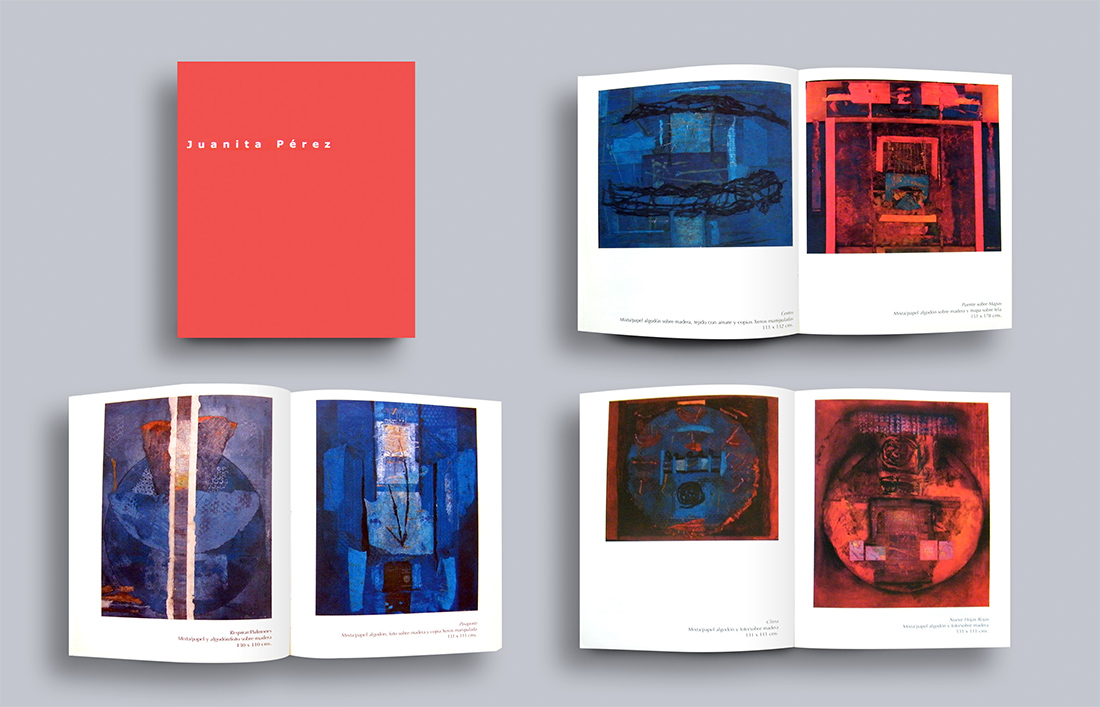- Hilos y Secuencias (Painted Strands)
- Artists of Casa Lamm in their workshops
- Vida
- Casa Lamm and its Artists
- Nombrar las cosas
- Internal Paradises
- Formations
- Desplazamientos
- Art In Embassies Program
- Árboles y Nidos (Trees and nests)
- Tejidos
- Arches-Bridges-Links
- Outside-Inside-Doors
- Ovens
- El ruido del tiempo
Internal Paradises
The paths of intuitionInternal Paradises
Casa Lamm
September 2004
In The beginning was the road.
Giorgios Seferis
By Germaine Gómez Haro
Since her early beginnings, Juanita has developed an original, artistic language which she uses to collide abstract figuration and compositions, based on simple, yet elegant geometric forms, while inserting meaningful signs and symbols that produce poetic insinuations. In her most recent works, exhibited in her new show entitled Internal Paradises, her incorporation of geographic maps reveal the conceptual intention that has been the motor of this work. Her roads mark the path of her existential and creative whereabouts. Her artistic itineracy incorporates a lattice of desires, frustrations, searches, encounters, losses, joys and uneasiness which can be read as a spiritual cartography and as a metaphor of her internal landscape.
Her imaginary geography incorporates memories filled with emotions, personal experiences and flashes from her own life. In the formal foreground of her paintings, these moments can be seen as an intersection reflecting a fine balance between geometric abstraction and vital expression, between skillfulness and the sensorial display of materials and colors that have liberated her painting from the confinement of simple lines and perspective. Her art creates a bridge that unites art and life, the internal and the external, the real and the imaginary, the present and the past. This creative act manages to achieve a synthesis of both matter and spirit. One of the most significant pieces in this exhibit is the polyptych entitled Crossing Borders, which interweaves the formal and the conceptual. In the artist’s own words, this work echoes “the desire to organize the disorder, to search for harmony and internal peace, using artistic language as a means of visual communication, while simultaneously expressing internal questioning”.
These paintings are characterized by explosive colors that create delirious, visual vibrations. Few contemporary artists dare to handle such extravagant combinations so successfully. This subtly evokes the uninhibited, free palate of Pedro Coronel. In her recent works, the artist concentrates almost exclusively on the richness of a single color per painting. Thus, predominate colors such as brilliant reds, mixed with grana cochinilla pigment or ethereal blues remind us of the mysterious tones often used by tlacuilo pre-Colombian Mayans. In these pieces, the tonal variations are quite subtle, almost monochromatic, except for the numerous layers of paint that sneak out of the diverse elements composing the work. The fragments, transpositions and ensembles of various materials and tones are softly woven together on the surface of her canvases, creating infinite combinations.
The richness of her materials and the quality and variety of textures she employs, has been a constant throughout her trajectory. The art of Juanita Pérez associates her philosophic and esthetic reflections with her control of technical aspects and tastes. The amate paper and the fragments of textiles used in her compositions mesh with her very personal interpretation of Mexico’s indigenous tradition, which made a lasting impression on her when she first arrived to this country. According to her, this work could not have been produced anywhere else in the world. Although her work could be considered “Mexican” if art could be given a nationality, it cannot be categorized within the realm of folklore or considered to be a superficial imitation of native Mexican art which pervades this country. Juanita Pérez has managed to absorb the essence of our cultural richness, and has integrated this with her own artistic background, resulting in a syncretism art form that follows the postmodern tendencies of our times, reverberating and penetrating echoes of ancestral voices while revealing a contemporary freshness.
Her paintings, sensual yet projecting a maddening control, are sumptuous, warm and sophisticated, but it is the philosophic background that imposes the formal beauty. Painting is –for Juanita Pérez- an act of retro-cognition, a way to explore her personal cartography, the internal and the external, life and death, the discovery of a Utopian Paradise which relies on the ephemeral contact with beauty, and which remains evanescence. Paradise for her is, “a vision of redemption and peace, of desire and need”.
Her desire is expressed in the essence of her art form which draws the paths of her intuition with rhythm, cadence, balance and harmony. In this collection, Juanita Pérez succeeds in fulfilling her intention, which is “to invent Internal Paradises, weaving, connecting, and reinventing geographies, dreaming of new links, and creating new ways of communicating, crossing physical and spiritual boundaries and betting on life.”
Her paintings, sensual yet projecting a maddening control, are sumptuous, warm and sophisticated, but it is the philosophic background that imposes the formal beauty. Painting is –for Juanita Pérez- an act of retro-cognition, a way to explore her personal cartography, the internal and the external, life and death, the discovery of a Utopian Paradise which relies on the ephemeral contact with beauty, and which remains evanescence. Paradise for her is, “a vision of redemption and peace, of desire and need”.
Her desire is expressed in the essence of her art form which draws the paths of her intuition with rhythm, cadence, balance and harmony. In this collection, Juanita Pérez succeeds in fulfilling her intention, which is “to invent Internal Paradises, weaving, connecting, and reinventing geographies, dreaming of new links, and creating new ways of communicating, crossing physical and spiritual boundaries and betting on life.”

